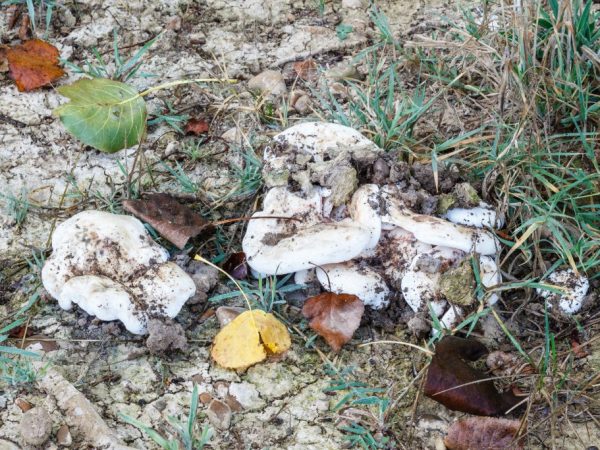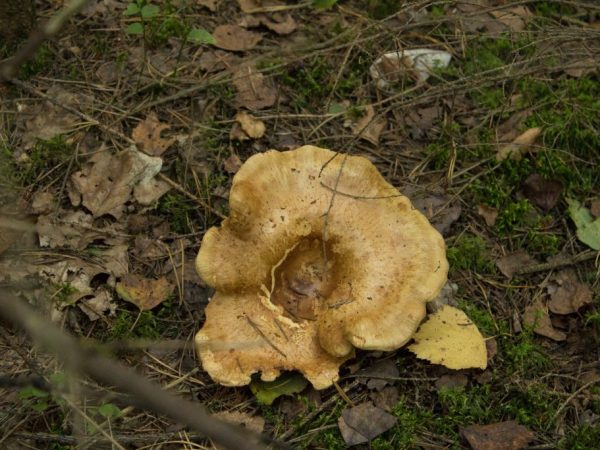Description of the aspen mushroom
Aspen mushroom is often found in our latitudes. This tasty representative of the Millechnik genus from the Russula family is widely used in cooking and medicine. Features of appearance, contraindications and other information about this mushroom should be known to every mushroom picker.

Description of the aspen mushroom
Description of appearance
The aspen milk mushroom belongs to the genus Mlechnik, like the boletus. The second name of this species is poplar mushroom. It secretes a characteristic sap - milky, when cut. The hat is dense and can reach up to 30 cm in diameter. Its minimum diameter is 5 cm. The middle of the cap is concave, there is a little mucus on it. The color is white, there is a slight pubescence along the edges.
Aspen mushrooms are conditionally edible mushrooms. The leg is short, voluminous, the flesh has a pungent taste. The fungus appears in summer and autumn; both groups and single specimens are found. A large number of delicious dishes are prepared with the help of aspen mushrooms. It has a light pleasant fruity aroma.
Any mushroom picker strives to find and collect the underfloor, as it is also called, but it can be difficult. There are several types of weight.
Mushroom species
Milk white: this type is the most common. They are looking for it in forests with birches - these can be deciduous and mixed forests. Searches begin in July and end in early autumn. The diameter of the cap is no more than 20 cm. The color is white or yellow. The leg of the mushroom is up to 6 cm in length and 5 cm in thickness, even, white. The main advantage of this species is that it most often grows in whole groups. Mushrooms hide under leaves. In cooking, this type is used only for pickles.
Milk yellow: the species is quite rare. It differs from the previous version in its intense yellow color. The edges of the cap are covered with reddish scales. This mushroom is also salted.
Irina Selyutina (Biologist):
The skin on the cap of the lump is yellow, golden or dirty yellow, sticky or slimy, in addition, it may have villi, making it "woolly". Like the rest of the mushrooms, there are concentric zones; they are hardly noticeable in the representatives of the species. When pressed at the site of damage, a slight browning of the surface is observed. The pulp is white, very dense, but at the same time brittle, has a pungent taste and a pleasant smell of fruit, turns yellow on the cut. Milky sap is white, but when exposed to oxygen in the air, it turns grayish-yellow. The leg is sticky on the outside, there is a cavity inside. Its whitish surface is covered with bright yellow pits.
This species is a mycorrhizal forming agent, which enters into symbiosis with representatives of coniferous tree species, giving preference to spruces and also with birches. As a place of residence, it prefers coniferous massifs, represented by spruce and fir, less often found in birch forests. Often settles in mountain forests. Fruiting from July to October.
Blue breast: the pulp is dense, yellowish in color, has a mushroom smell and a sharp taste. The milky white juice, which is released from the mushroom when cut, becomes dark purple over time.
Aspen milk: is relatively rare, it grows in forests with poplars, but most often near aspens. This mushroom has a white cap, occasionally pinkish spots are found on it. The skin is covered with a small fluff. It becomes sticky in wet weather. Mycorrhizal forming fungus root with willows, aspens and poplars. It is salted before use.
Black breast: got its name due to the presence of a brown middle and the same edges of the cap. When cooking, the color smoothly turns into red. The pulp is white, gray when broken. Occurs in mixed forests and birch forests. The mushroom is ideal for salting.
Irina Selyutina (Biologist):
Black lactose is sometimes confused with another conditionally edible species - black lump. However, you can find the differences:
- Habitat: Mr. black is found in mixed forests and birch forests, and item black is found in coniferous areas.
- Hat:
- cap color: in black, it is dark olive, and in the load it is dirty brown;
- cap edge: for black, the felt edge of the cap is characteristic, for the load, the entire surface of the cap is smooth;
- head surface: in black, it has weakly noticeable concentrically zones (sometimes they are absent), the skin is mucous. The load has a slightly sticky skin, there are no concentric zones of a darker color.
- Pulp: in black, it is white, gray at the cut. The load is characterized by the presence of a pinkish color, which darkens with age, and blackens on the cut.
- Milky juice: in underload it is absent, in Mr. black it is very plentiful and very pungent in taste.
- Hymenophore plates: in the load the plates are black-gray, and in the black one they are light.
- Coloring after salting: podgruzdok - turns black, h. the lump becomes purple-burgundy.
Pepper milk: this type of milk is characterized by a blue tint of the pulp when cut. The hat can be smooth or slightly velvety. Grows in oak forests, most often found in the Caucasus. The species is characterized by variability in the color of the cap: it can be white or cream. The plates can also change their color from white to cream. Dried and powdered mushroom can be used in place of pepper.
Beneficial features
Aspen (poplar) mushroom has a number of useful properties:
- used as a diuretic;
- removes kidney stones;
- destroys pathogenic bacteria;
- fights tuberculosis;
- has a beneficial effect on immunity;
- improves memory and brain activity;
- improves digestion;
- treats nervous disorders;
- normalizes sugar levels;
- clears blood vessels from forming cholesterol plaques;
- helps in the fight against obesity;
- copes with warts.
Contraindications

Milk cannot be eaten raw.
The aspen mushroom also has a number of contraindications. It is forbidden to use it:
- people with stomach and intestinal problems;
- children under the age of 7;
- suffering from pancreatitis.
It is also worth considering that the mushroom is difficult to digest due to the large amount of chitin. It should not be eaten raw; be sure to process it before cooking.
Application
Milk mushrooms, according to the description, are used in the preparation of various dishes, as well as for medical purposes.
In cooking
Useful proteins in the composition of the mushroom make up more than 30%, so aspen milk mushroom is much more satisfying than beef. It is better to salt it, although it is possible to cook other dishes. The main thing is to correctly carry out preliminary processing, which will completely remove the bitterness.
In medicine
Milk mushrooms have become widespread in pharmacological preparations. Some of their types are part of the means that fight Koch's bacillus.
There are recipes, including for the preparation of tincture of milk mushrooms for the treatment of lungs, kidneys, diabetes mellitus.
Growing
To grow on mycelium on the site, the easiest way is to take an overripe poplar mushroom, dry it, chop it finely and lay it in the prepared soil. In the next 5 years, the gardener will have a bountiful harvest of mushrooms.This is best done between May and September.
Conclusion
Aspen mushroom is one of the most popular mushrooms in Russia. It is often grown in plots and used in medicine.



